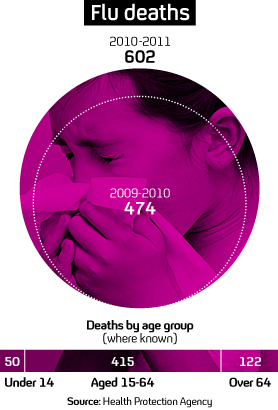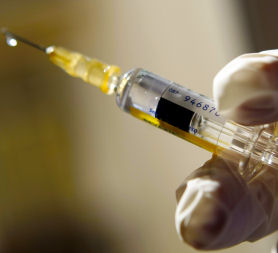Young and middle-aged hit hardest by flu
As new figures show a rise in the number of flu deaths, a world-renowned influenza expert tells Channel 4 News the Government’s decision to axe a flu ad campaign was a “big mistake”.

The Health Protection Agency (HPA) annual flu report reveals 602 people in the UK died with a confirmed influenza infection during the 2010-11 season.
More than 90 per cent of deaths – 535 out of 582 – were influenza A H1N1 swine flu. Influenza B was associated with 40 deaths. The figure compares to 474 deaths from influenza during the 2009 epidemic.
415 deaths – over 70 per cent – were in young and middle aged people aged 15-64. 122 people aged over 64 died from flu, around 20 per cent of the total.
Across all age groups, almost 70 per cent – 373 out of 555 – of those who died this season were in a clinical “at risk” group for vaccination.
Vaccinations
The HPA said information on vaccination history was available for just over half of the fatal cases, and almost 75 per cent – 229 out of 307 – had not received the flu vaccine this year.
They also revealed just 50 per cent of adults under 65 who were in an “at risk” group and eligible for flu vaccination last season received the vaccine, down slightly from the 2009/10 season. Among over 65s in England, all of whom are offered vaccination, 73 per cent accepted – up slightly from the previous year.
Flu vaccination was introduced routinely to all pregnant women as they were disproportionally affected by the H1N1 strain during the 2009 pandemic and are more at risk of serious complications.
But just 37 per cent of healthy pregnant women in England were vaccinated, while among pregnant women with underlying conditions the figure was 57 per cent.
To date, nine pregnant women are reported to have died from flu this season.
We are very concerned that only half of adults eligible for the jab last winter took up the offer. Professor John Watson, HPA
Immunisation figures were better in Scotland, where 57.4 per cent of at-risk under-65s were immunised and 74.5 per cent of over-65s.
Professor John Watson, head of the respiratory diseases department at the HPA, said: “We are very concerned that only half of adults eligible for the jab last winter took up the offer of vaccination, and particularly that just over a third of healthy pregnant women received it.
“For the majority of people with these conditions, flu is a preventable illness, and ahead of the next flu season a concerted effort must be made by healthcare professionals, including GPs and midwifes, to encourage those at risk to take up the offer of vaccination. It is the best way to protect against flu,” he added.

Winter flu advertising
A Department of Health spokesperson told Channel 4 News that the Government stands by its decision to axe an annual £1.5m winter flu advertising campaign.
“Following last winter, the Department of Health has reviewed the evidence base for mass media campaigns in driving uptake, and it is neither possible to prove nor disprove that advertising makes more people get vaccinated. Vaccine uptake rates in 2010 were very similar to previous years,” the spokesperson said.
“There will not be a national vaccination campaign this autumn,” the spokesperson added.
The Department of Health also said it was consulting on how to improve the number of people who choose to vaccinate themselves against flu.
But John Healey MP, Labour’s Shadow Health Secretary, said the issue concerned awareness, and he criticised Health Secretary Andrew Lansley for cutting the advertising campaign.
A large part of the blame for the rise in deaths from swine flu last winter lies at the door of Andrew Lansley. John Healey, Shadow Health Secretary
“A large part of the blame for the rise in deaths from swine flu last winter lies at the door of Andrew Lansley. He’s the one who cancelled the flu-jab advertising campaign that had previously targeted those most at risk. The Health Secretary should make clear what lessons he has learnt to prevent this happening again,” Mr Healey said in a statement.
World-renowned influenza virologist Professor John Oxford told Channel 4 News there was no doubt that advertising works.
“The similarity in the vaccine uptake figures can be explained by counter-advertisements on blog sites, on Twitter, where there is a huge anti-vaccine campaign to put people off,” he said.
“Advertising works. They had a successful campaign with the over 65s, but the rest of the groups have been left drifting, and that worries me,” Professor Oxford continued.
“This whole issue of why people aren’t getting vaccinated is about perception. And the solution to that is education, then action. Of course, it is easier said than that done, but the decision to stop the media campaign is surely a big mistake.”